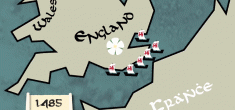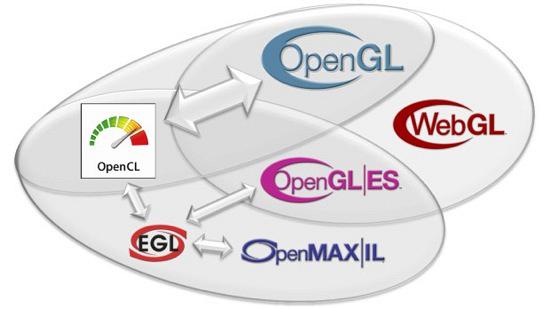Το ΟpenGL δεν πιστεύω πως χρειάζεται ιδιαίτερες συστάσεις... όπως είναι ήδη γνωστό οι περισσότερες φορητές συσκευές που κυκλοφορούν συμπεριλαμβανομένων των iPhone, iPod, iPad χρησιμοποιούν OpenGL ES, ενώ σιγά σιγά βλέπουμε και άλλα μέρη του να αρχίζουν να προστίθενται στην οικογένεια, όπως είναι το OpenAl και OpenCL. Ήρθε η ώρα για την τέταρτη έκδοση του OpenGL ενώ το DirectX μένει πίσω...
Το πιο "καυτό" ζήτημα σε 3D στις μέρες μας είναι οι φορητές συσκευές. Το Mobile Gaming είναι παντού. Το OpenGL το γνωρίζει αυτό και ως τώρα έχει καθαρά το πάνω χέρι, ενώ η Microsoft και η δική της βιβλιοθήκη γραφικών (DirectX) είναι χαμένοι... Μην με παρεξηγείτε είμαι σχεδόν σίγουρος ότι τα νέα παιχνίδια σε Windows Phone 7 ή στο Zune HD2 θα είναι εξίσου καλά, αλλά μην ξεχνάμε ότι το OpenGL είναι ελεύθερο και ανοικτό λογισμικό - σε αντίθεση με το DirectX.
Θα μπορούσα να κάτσω να αναλύσω όλα τα νέα χαρακτηριστικά της τέταρτης έκδοσης αλλά είναι πολλά και σίγουρα πιο πολύ τεχνικά από ότι φαντάζεστε. Το μόνο σίγουρο είναι ότι όλα μεταφράζονται σε: α) Καλύτερα γραφικά β) Καλύτερη απόδοση γ) Χαμηλότερη Κατανάλωση
Λιγάκι πιο συγκεκριμένα το OpenGL 4 δείχνει να επικεντρώνεται στον διαμοιρασμό επεξεργαστικής ισχύς, δηλαδή στο κομμάτι του OpenCL, το οποίο μπορεί να δίνει στον επεξεργαστή της GPU και άλλα πράγματα να κάνει ... όπως παραδείγματος χάριν την αποκωδικοποίηση ενός βίντεο. Σίγουρα είναι ωραίο να βλέπουμε τέτοιες εξελίξεις και ο ανταγωνισμός μάλλον τελικά θα βοηθήσει στην δημιουργία καλύτερων φορητών συσκευών για όλους.
Παραχωρώ την ανακοίνωση για το OpenGL 4:
March 11, 2010 – San Francisco, GDC 2010 – The Khronos™ Group today announced the release of the OpenGL® 4.0 specification; a significant update to the most widely adopted 2D and 3D graphics API (application programming interface) that is used on all major desktop operating systems. OpenGL 4.0 brings the very latest in cross-platform graphics acceleration and functionality to personal computers and workstations and the OpenGL standard serves as the basis for OpenGL® ES, the graphics standard on virtually every shipping smart phone.
The OpenGL 4.0 specification has been defined by the OpenGL ARB (Architecture Review Board) working group at Khronos, and includes the GLSL 4.00 update to the OpenGL Shading language in order to enable developers to access the latest generation of GPU acceleration with significantly enhanced graphics quality, acceleration performance and programming flexibility. This new release continues the rapid evolution of the royalty-free OpenGL standard to enable graphics developers to portably access cutting-edge GPU functionality across diverse operating systems and platforms. The full specification is available for immediate download at http://www.opengl.org/registry.OpenGL 4.0 further improves the close interoperability with OpenCL™ for accelerating computationally intensive visual applications. OpenGL 4.0 continues support for both the Core and Compatibility profiles first introduced with OpenGL 3.2, enabling developers to use a streamlined API or retain backwards compatibility for existing OpenGL code, depending on their market needs.
OpenGL 4.0 has been specifically designed to bring significant benefits to application developers, including:
- two new shader stages that enable the GPU to offload geometry tessellation from the CPU;
- per-sample fragment shaders and programmable fragment shader input positions for increased rendering quality and anti-aliasing flexibility;
- drawing of data generated by OpenGL, or external APIs such as OpenCL, without CPU intervention;
- shader subroutines for significantly increased programming flexibility;
- separation of texture state and texture data through the addition of a new object type called sampler objects;
- 64-bit double precision floating point shader operations and inputs/outputs for increased rendering accuracy and quality;
- performance improvements, including instanced geometry shaders, instanced arrays, and a new timer query.
Lastly, Khronos has simultaneously released an OpenGL 3.3 specification, together with a set of ARB extensions, to enable as much OpenGL 4.0 functionality as possible on previous generation GPU hardware, providing maximum flexibility and platform coverage for application developers. The full OpenGL 3.3 specification is also available for immediate download at http://www.opengl.org/registry
“AMD sees the release of OpenGL 4.0 as another major accomplishment for the OpenGL ARB,” said Ben Bar-Haim, vice president of design engineering at AMD. “AMD contributes to the Khronos workgroups, and we consistently find that Khronos is successful at developing healthy, thriving, and evolving open standards such as OpenGL and OpenCL.”
“OpenGL 4.0 continues the ARB’s schedule-driven roll-out of new functionality, and this significant major release enables developers to access leading-edge GPU functionality across multiple platforms with full backwards compatibility,” said Neil Trevett, president of the Khronos Group and vice president at NVIDIA. “OpenGL continues to be a keystone in Khronos’ API ecosystem through driving innovation into OpenGL ES and WebGL™ to bring high-performance programmable graphics to mobile platforms and the Web, and by interoperating with OpenCL to create a seamless visual and compute platform for application developers.”
Learn about OpenGL at Game Developer Conference March 11-13, 2010
Attend this session to learn about the latest updates on the OpenGL standard, and how the OpenGL ARB is addressing the latest graphics hardware capabilities. Also discover how WebGL is bringing OpenGL based graphics to browsers on any platform supporting the OpenGL or OpenGL ES standards, without the need for any plug-in. Additionally, Khronos is offering sessions on OpenCL, COLLADA, and Khronos Mobile APIs.All Khronos GDC Sessions are in Room 123, North Hall, Moscone Center, San Francisco:
OpenCL Thursday, March 11 1:30pm – 2:30pm
OpenGL featuring WebGL Thursday, March 11 3:00pm – 4:00pm
COLLADA featuring WebGL Friday, March 12 1:30pm – 2:30pm
Mobile featuring WebGL Friday, March 12 3:00pm – 4:00pm
About The Khronos Group
The Khronos Group is an industry consortium creating open standards to enable the authoring and acceleration of parallel computing, graphics and dynamic media on a wide variety of platforms and devices. Khronos standards include OpenGL®, OpenGL® ES, WebGL™, EGL™, OpenCL™, OpenMAX™, OpenVG™, OpenSL ES™, OpenKODE™ and COLLADA™. All Khronos members are able to contribute to the development of Khronos specifications, are empowered to vote at various stages before public deployment, and are able to accelerate the delivery of their cutting-edge media platforms and applications through early access to specification drafts and conformance tests. More information is available at http://www.khronos.org.
[via]





Φίλε μου, αυτά που κάνει η OpenGL 4.0 τα κάνει εδώ και καιρό το DirectX 11 και φέρνω σαν παράδειγμα το υποχρεωτικό tesselation και shader computing units.
Πολλές από τις αλλαγές που υποσχέθηκε το OpenGL (να έρθει πιο κοντά το API του στη λογική του Direct3D) δεν έγιναν, επομένως μην περιμένετε υποστήριξη από τους game developers.
Το OpenGL δυστυχώς θα παραμείνει ένα βήμα πίσω από το DirectX.
Sorry, αλλά έτσι είναι.